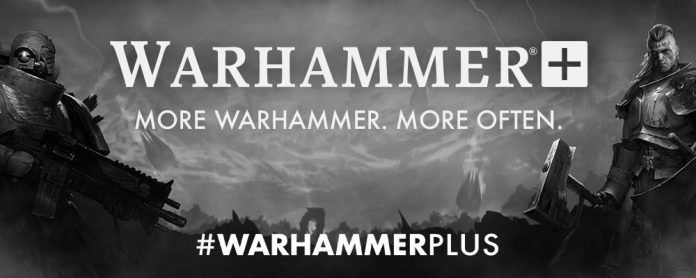Author’s disclosure: Goonhammer was given a free month of Warhammer+ back in August.
Were I trying to deliver on the promise of this title format, this is the part of the article where I would post a before and after picture of myself. I regret to inform you that I have led you astray. Your estranged aunt was correct, everyone on the Internet is a liar. Now that my bamboozling and subsequent formal apology are out of the way, I’m going to talk about Warhammer+, Games Workshop’s bespoke streaming service/Quibi-killer/kitchen sink containment unit, and how it has shaped up over the course of its initial 6 months.
Over the next Entirely Too Many Words, I’ll go over the exclusive stuff on Warhammer+ and share my almost entirely unqualified thoughts on them. I won’t cover the content GW has uploaded already on its official YouTube channel as you can watch that on your own, and there’s enough reuploads of Astartes that you can find that easily enough too. You should watch Astartes though, it owns.
Hammer and Bolter
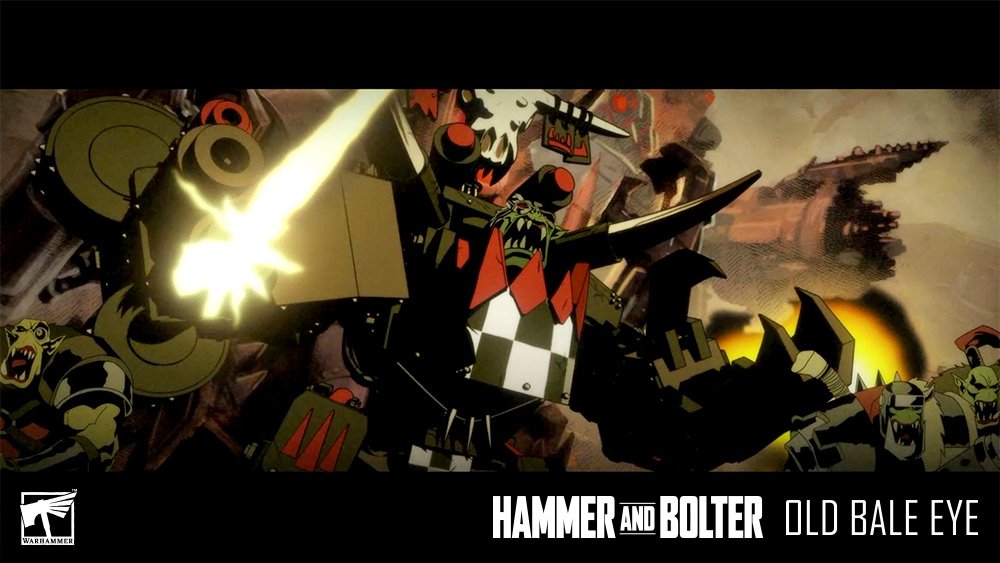
Back in August, Warhammer Community previewed Old Bale Eye, an episode of its anthology series Hammer and Bolter. I reviewed this back then, and I will quote myself as it’s easier than writing something new:
The tl;dr here is that this first episode of Hammer and Bolter comes off as being a bit low budget, but makes up for it with style and charisma. The storytelling is solid, the art is enjoyable to look at, and the team behind it clearly cares about what they’re making.
As I have watched more Hammer and Bolter (The Bolter is well-covered at this point, though the Hammer is yet to come) I have found it to be fairly consistent. Each episode tells its short story with panache and no small amount of attention to detail. However, the strength of the format is not in the stories of the biggest, baddest, proper noun-iest heroes of the setting, but in the small moments and margins of the 41st millennium. As I so plainly put back in August, the show has definite budgetary constraints. This lower budget means the big battles you may read about in a Black Library novel or play out on the tabletop are generally limited to panning shots of static images and a few key bits of animation, much like the 90s anime that inspired the show. The smaller stories where animators aren’t working with as many moving pieces tend to look better and play to the strengths of the small budget and small team. It is a show that often looks better in still images than in motion, but is a routinely enjoyable glimpse into some dark corner or another in the worlds of Warhammer.
Angels of Death
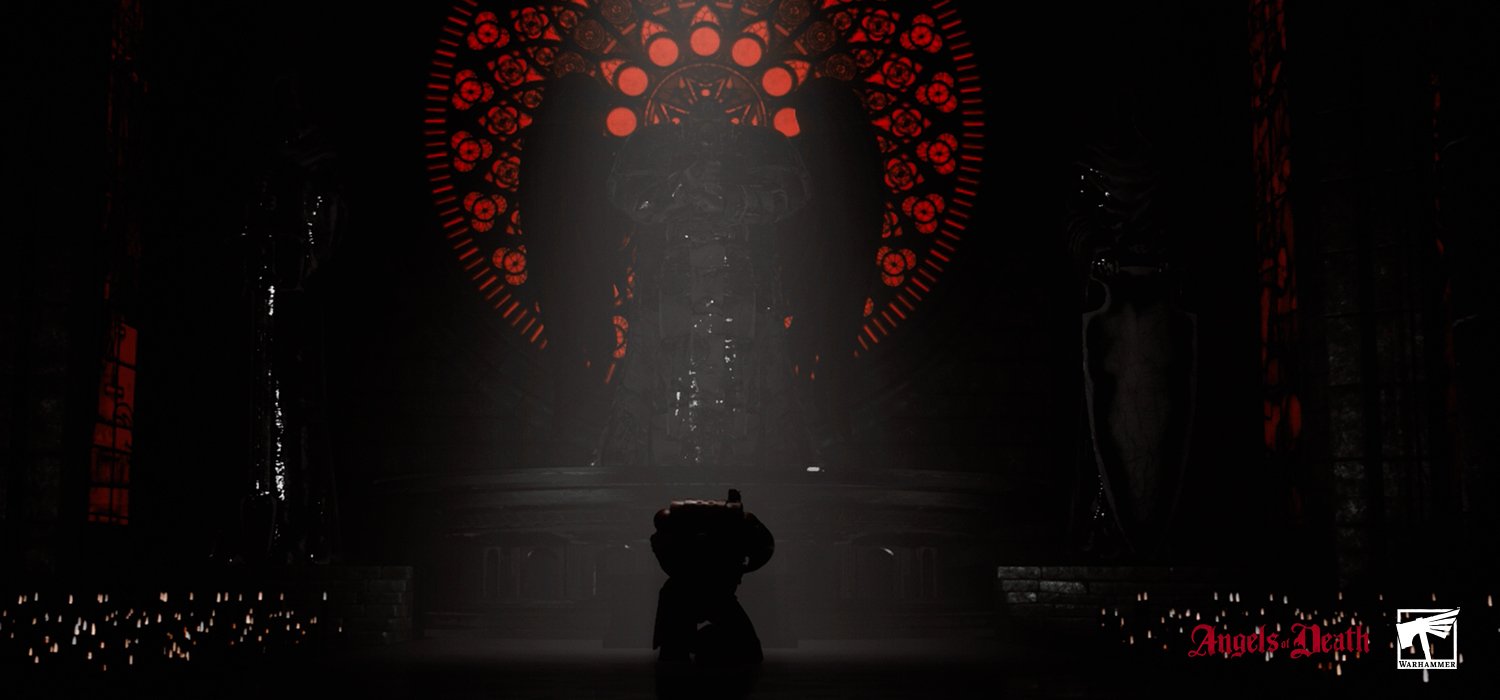
This is the more expensive looking animated series on Warhammer+, and the one that carries a pedigree of quality from one Richard Boylan. We here at Goonhammer are Certified Helsreach Enjoyers, so seeing the maker of this ambitious but smartly made fan animation get a shot at the big leagues was an inspiring little success story. Angels of Death features prominently in the early sizzle reels and advertisements, and it’s clear to see why. It’s got sweeping camera moves, detailed character models, and 3D ship combat that all have at least some degree of “wow” factor to them. The aesthetic is also doing that Sin City thing, where it’s all black and white save for a pop of red. Speaking to Boylan’s previous experience, this stylization does the show a lot of favors and helps keep the viewer focused when the camera decides to go Bourne Trilogy Mode and shake itself to death like my old dryer. I suspect the heavy camera shake is to hide some less detailed animation, but for the most part this show looks pretty dang good. The action scenes are largely impressive, the city they fight through is suitably huge and gothic looking, and the character models are detailed and expressively animated. Faces fall somewhere near the uncanny valley in a real “mid-lifecycle Xbox 360 game” sort of way, but I wasn’t expecting photorealism here.
The characters and story of Angels of Death are fighting an uphill battle to be memorable, as it’s a very typical Warhammer story. Some Marines go to a planet because something seems wrong, and, shocker, something is very wrong. I’m being reductive not out of malice but largely because I’m having a hard time remembering what really happened beyond the broadest strokes. Some of this may be down to the weekly-ish release schedule, but when you have an episode that’s largely a visually impressive tunnel fight action sequence, the narrative kind of goes in one ear and out the other. Binged on a rewatch it might stick better.
The story is focused around a tactical squad and their supporting Chapter staff. The central tactical squad doesn’t have much characterization beyond their armor and weapon variations. Its sergeant, freshly back from the Deathwatch, is suffering Black Rage symptoms, and that’s cool to see bubble up, both visually and narratively. He has an interesting dynamic with his Chaplain who serves as a spiritual guide. It’s the kind of thing you read about often, and is cool to see acted in motion. Said Chaplain oscillates between being a gentle, encouraging figure and shouting out litanies of zeal and pulping Genestealer skulls, so you can’t say he doesn’t have dimensions to him. Onboard their ship there is a Techmarine who is probably my favorite character on the show. He’s witty and muses to himself often, and his dialogue is written with a poetic flair that stands out from the courage and honor, duty and loyalty stuff Marines usually yell at each other. Lastly, the ship’s captain is in the Lotara Sarrin mold and is genuinely respected by the Marines, which is cool to see. She’s allegedly in over her head in the position, but is written to be as competent as anyone else in the cast.
From an audio standpoint, the highlight would be the Vangelis-style synth score running throughout. It’s unexpected compared to the music in other Warhammer media, which is usually store brand Hans Zimmer by way of Basil Poledouris. Bolters boom, ‘stealers scream, and ships explode in a satisfying way. There’s maybe like, 70% as much sound layered in as there should be in a scene which can sometimes feel a bit empty, but what’s there is strong.
Ultimately, the strength of Angels of Death is as an ~aesthetic~ experience. It captures the look and feel of the setting, the scale of its environments, and the threat of its monsters. It didn’t shock me and the story clearly didn’t stick with me, but I had a good time.
Deep Strike
I contain within me enough empathy that, should someone ponder aloud “who is this even made for?” I can picture an individual, real or imagined, in response. This time around, searching my mind index for “who is this made for” comes up with no conclusive results, nor does the related search of “what kind of person would enjoy this”. For all I know, you may be that person, as different strokes are, indeed, for different folks. I regret to inform you that we have not met yet, and I did not conjure you up in my mind palace while thinking about this show.
Deep Strike takes the form of a roundtable discussion with Adam Troke and a pair of other Warhammer TV personalities – Lousie, Peachy, Wade and the like. Let it be known I have no qualms with any of the hosts here – I find them to be charismatic and enjoyable people to watch in most of their appearances. The first half of each episode will be the panel going through another Warhammer+ series, episode by episode, and talking about their favorite parts. This mostly boils down to them describing things that were much cooler to watch the first go around without offering much insight – these segments are quick and extremely surface level. As they are not media critics and this is an official GW show on an official GW platform, they can only say so much and only be so critical, seldom going beyond “it was rad when that dude’s head blew up”. The second half of each episode consists of interviews with the casts and crews of the productions, which I thought would be the show’s saving grace. It was not. Again, these are surface level at most, rarely going deeper than “Playing a Space Marine is cool because you get to be a very big guy”.
The prospect of a show going behind the scenes into what decisions were made and why could be hugely interesting, but this firmly ain’t it.
Loremasters
I have semi-jokingly called Goonhammer’s own Craig Sniffen “Loremaster” several times since he helped carry our team to victory at Adepticon Team Trivia in 2019. This is not a show about him, although I would watch that too. Instead, Loremasters has Wade Pryce go in depth on one particular person, place, or thing from the worlds of Warhammer. Think of it like those lore channels on YouTube, but good instead. Wade has a good delivery for this sort of thing, and the production values are lavish for what could have been a Powerpoint presentation. Music, high definition artwork, pleasing screen transitions and Pryce’s wry narration make this show particularly enjoyable. Most episodes also end with a detailed 3D model of the episode’s subject doing some character select screen-esque attacks at the camera. It seems like kind of an expensive thing to drop in there at the very end unless they’re going to pit them all against each other in a Super Smash Bros-style Warhammer platform fighter (please make this), but it’s a cute note to end on. I wish Loremasters had some background on the real world inspirations for these subjects, but alas, we’ll never truly know who Sly Marbo is based on.
Battle Report
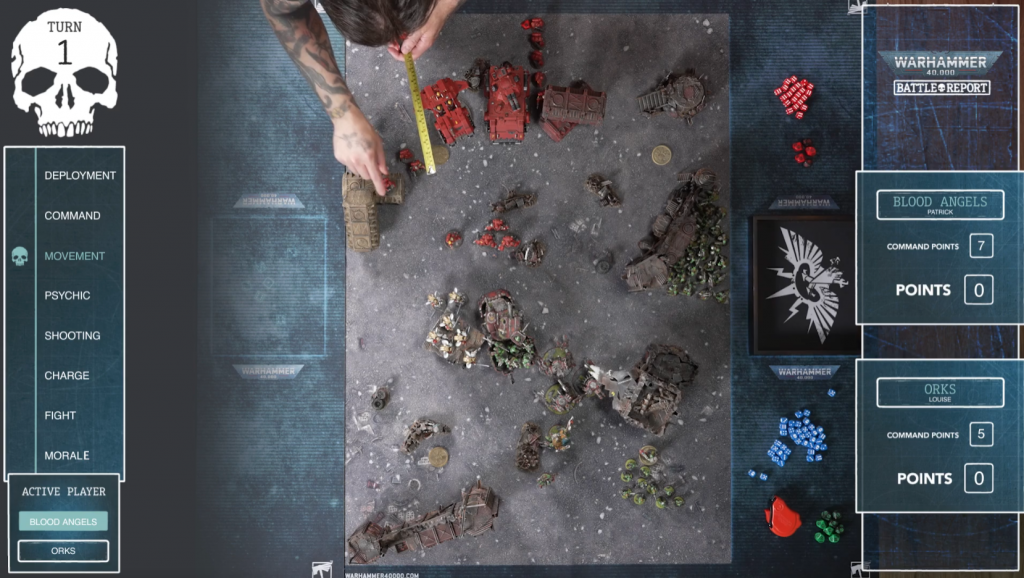
I reviewed this one a while back, and decidedly little has changed about it. “Warhammer with your coworkers” is still the vibe, with a pair of energetic Warhammer TV folks duking it out between slightly stiff reads of prepared statements. To quote myself again:
…this is the White Dwarf battle report in video form, with all that entails.
There is a mix of Matched Play, Narrative, and, against all odds, Open Play on display here, between a variety of game systems. The Matched Play episodes won’t make you the next Richard Siegler, but are a decent approximation of the kind of game you would play with a friend. I have only watched one Open Play game, but it was largely indistinguishable from the Matched Play ones, save for the occasional fudging of rules with a “eh, it’s Open Play why not” beforehand. The Narrative games aren’t Crusade-style, but closer to the kind of narrative game you might play at a convention or in an older Imperial Armour book where the mission and forces are themed around a story. These are where Battle Report comes into its own.
While there’s no shortage of people posting battle reports on YouTube, none have the wealth of resources of the Warhammer TV team. Some, like the Garden of Iax report, have themed tables and win conditions. This is neat! Then you have something like this holiday season’s Kill Team report where a Space Wolves Kill Team had to play Grinch to Da Red Gobbo. This was a buckwild mission with a group of Grots themed around Santa and his helpers, an Abominable Snow Squig, a bespoke Santa’s Workshop board, and special punny rules and stratagems. In an Extremely British move, they even pulled Christmas crackers to determine priority. This was the most fun I’ve seen anyone have on this entire streaming service, and was truly something special.
The production for all of these is slick, with pop-up video boxes explaining the rules they namedrop, plenty of graphics showing what’s going where, and legible camerawork. As someone who also has trouble understanding rules in abstract, seeing a game played helps a lot and is probably why Kill Team and AoS 3.0 both make sense to me despite playing so little of either. What I’m getting at is this show is pretty good.
Citadel Masterclass
When Louise Sugden announced she was joining the Warhammer TV team back in April last year, I was confused. If you follow her on Instagram (and you should) you’d know her painting style isn’t really what you’d expect from the “tip of the day” and “battle ready” painting tutorials Warhammer TV was known for at the time. Turns out this is what she was working on, and it kicks ass. Citadel Masterclass blows up one thing – faces, lenses, wet blending, or what have you – and goes in detail about how to accomplish it to an ‘Eavy Metal standard. Louise’s presentation style is infectiously enthusiastic, and her natural charisma comes through in her instruction. Experienced painters who want to level up their painting are the target audience here, but even an army painter or newcomer can still pick up a thing or two. I also cannot tell you how refreshing it is to see someone who isn’t a 30-50 year old white dude presenting official GW material. This is one to watch, and to many, the most appealing thing on the whole service.
The Vault

This is weirdly one of the more compelling things here for me. I love reading old Whites Dwarf, codices, and so on, and have a sizeable collection thereof. Including what are essentially watermarked and non-downloadable .PDFs of old publications is pretty cool to me. A lot of these old products are curiosities and not really worth much on their own to the majority of warhams, but they’re firmly playing to whatever seat I’m sitting in. I do wish there was a dedicated app for these though; having to open a browser window on my desktop or mobile device and browse through them is a slightly clunky experience. It also means you don’t have a bookmark feature, which is annoying. Still, I’m glad they keep adding stuff every week, even if for every compelling addition (Warhammer End Times books! Imperial Armour!) there’s a few years of White Dwarf: Less Good Edition. They’re also just kinda jumbled all up in there without any sort of categories, so it’s like digital dumpster diving right now if you want to find something specific.
Most of the old books have the rules stripped out, which I feel two ways about. On the one hand, it means GW isn’t essentially selling an outdated product that could cause confusion for a reader. On the other, it means these are an incomplete picture of a previous era. For this reason, they’re usually titled “Warzone Buttchug: The Lore” or whatever. That also limits what they can upload to a degree, as previous eras of Warhammer often had a blurrier line between the fluff and crunch sections.
This has loads of promise from an archival/preservation standpoint, however. Time will tell, but it’ll be real cool if they start including some of the gonzo retro stuff from the 80s and 90s. When the zoomers at the game store tell me I “look 40” I can now show them what was going on when I was their age. “That’ll show ’em!” I’ll say to myself, as I crumble to Citadel Finedust and blow away in the wind.
The Apps
Hot take: The 40k app launched in a less-than-ideal state. Lukewarm take: the app is pretty decent now. I’ve used the AoS and 40k apps for a bit of messing around and they work pretty well. I spend enough time staring at the Stress Rectangle as is so I prefer printed materials, but I’m glad they’re included in the price here. You get the 8th edition 40k and 2nd edition AoS stuff for free with your subscription, but as each book gets updated, the new army abilities and such require a code from buying the physical rulebook. This kinda bites since it’s the one part of your Warhammer+ membership that actually gets less valuable the longer you have it. Still, the base apps are useful, and if you’re using them anyway it’s nice to have access to all the premium features.
The Models
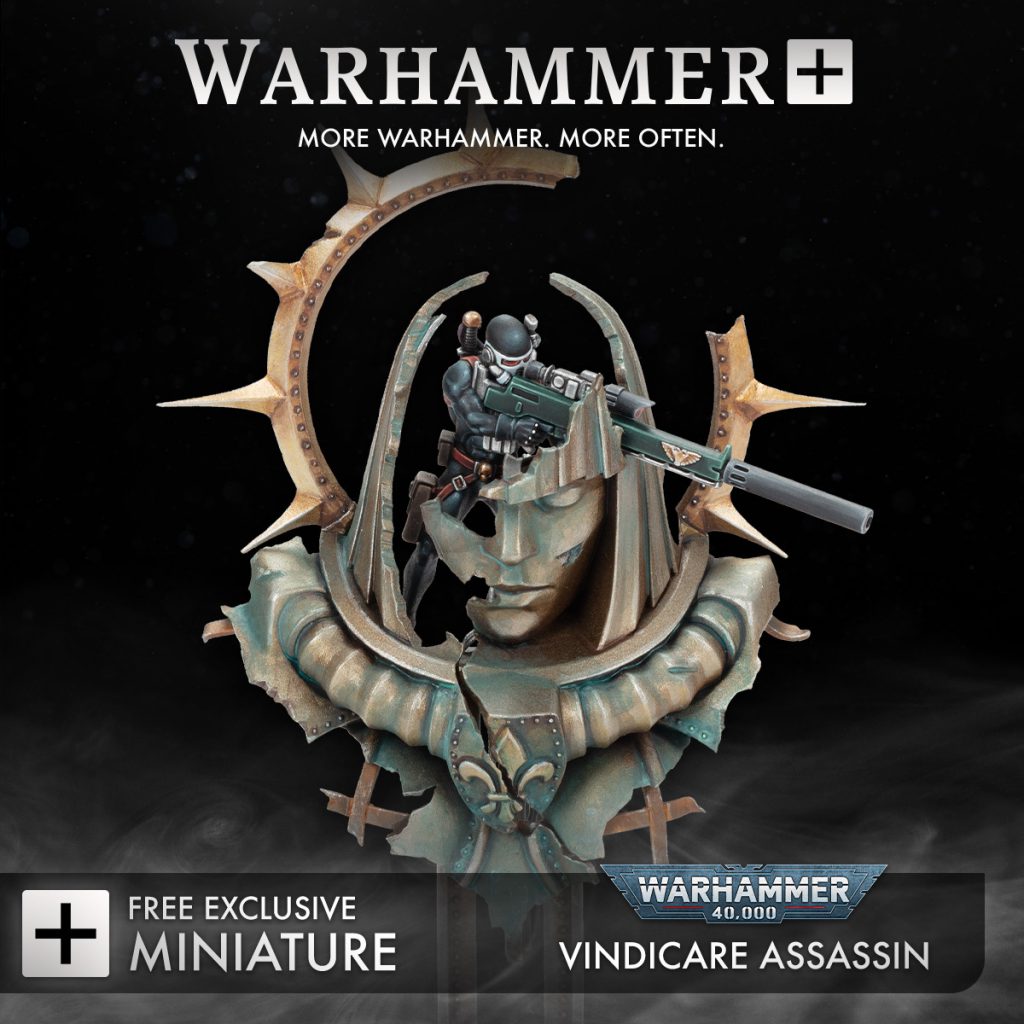
As of writing, I have not yet received my subscription model. We’ve probably talked about them in one hot take or another, but the Orruk Megaboss is pretty good, if unremarkable, while the Vindicare on his Hero Building is extremely cool. The value prospect of Warhammer+ is significantly boosted when you factor in a $30-$40 character model, and when they’re as cool as the Vindicare that’s a pretty easy pill to swallow.
Vouchers, VIP Stuff, and What Have You
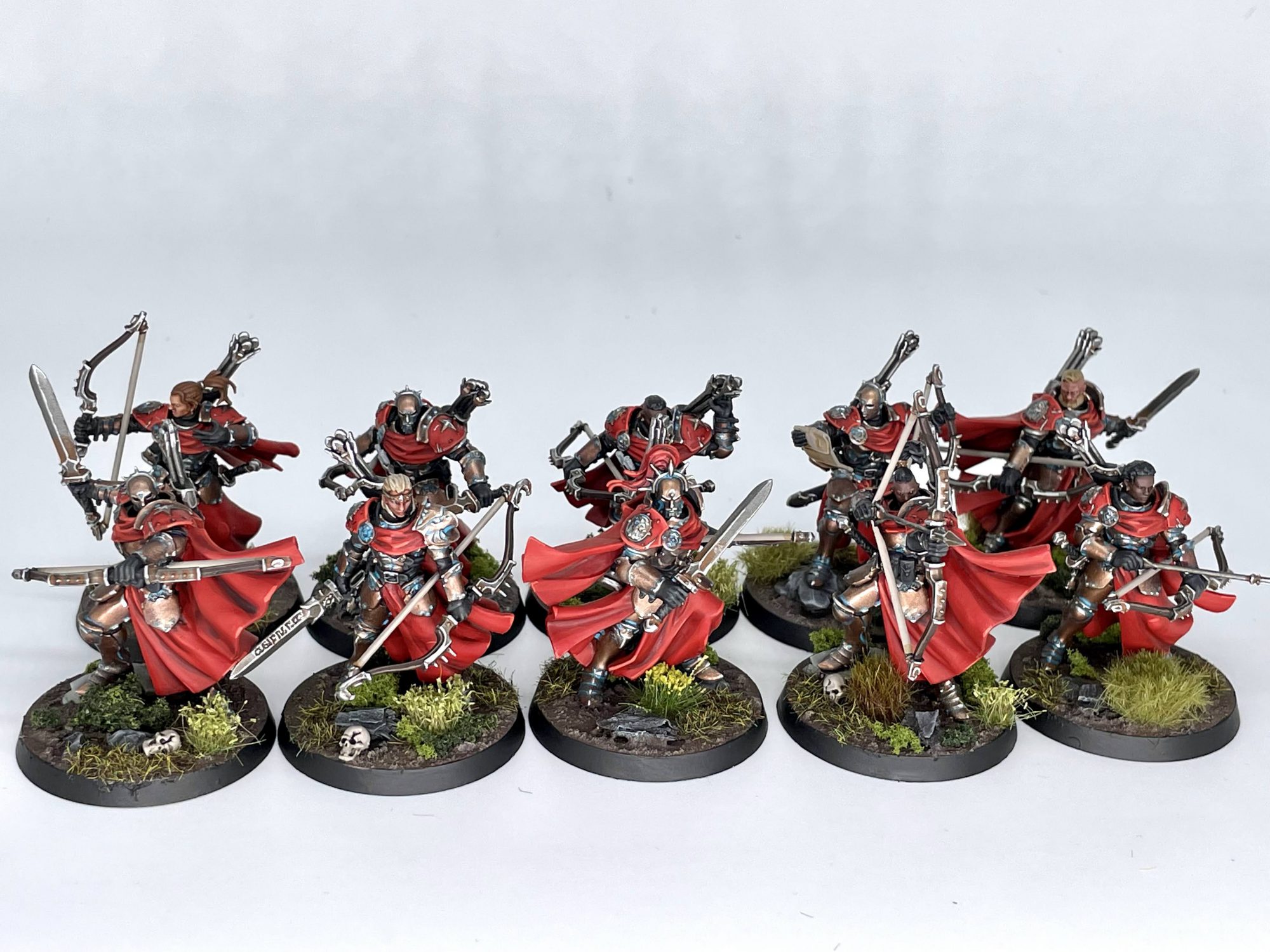
So far I think I’ve only gotten one voucher for my troubles, usable on the GW webstore. Between that and the exclusive Warhammer+ model, this practically paid for itself, and I dig that. There’s also been talk of con swag and VIP treatment at events but I haven’t really seen anything of the sort as of yet. Exclusive deals available to the Warhammer Bourgeoisie is a pretty good selling point.
TL;DR
There is a kitchen sink, borderline-overwhelming nature to what’s on offer with Warhammer+. Much grousing has been made about the weekly video content trickle, but it’s clear the video team is small and this stuff takes a load of work. The only stinker of the bunch is Deep Strike, and with promise of more shows coming out, the value should only get better. Meanwhile, the apps become less valuable as more content is paywalled, but they’re plenty usable. The Vault, should they continue adding stuff, is a fun source of curiosity, but could stand to be better organized or run in its own app. The more tangible goodies of models and vouchers are pretty dang cool, and show promise for the future.
It’s ultimately up to you if you think this all sounds worth it, as I am not your dad nor do I wish to be. Personally, I think this bevvy of stuff is worth the few bucks a month. If you really want to give it a go, a month is 6 bucks or your local equivalent. For the price of a middling draught IPA or an above average latte, it’s as low a risk investment as you’ll ever find in this hobby.
Have any questions or feedback? Drop us a note in the comments below or email us at contact@goonhammer.com.
